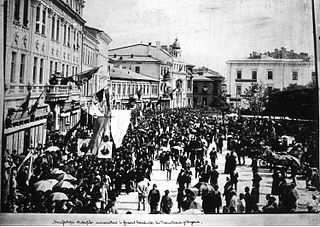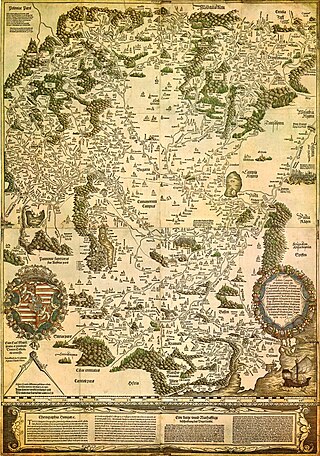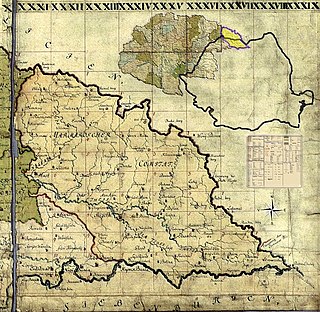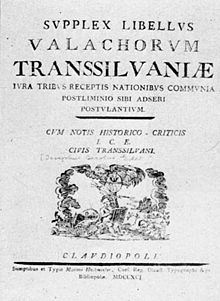
Transylvania is a historical and cultural region in Central Europe, encompassing central Romania. To the east and south its natural border is the Carpathian Mountains and to the west the Apuseni Mountains. Broader definitions of Transylvania also include the western and northwestern Romanian regions of Crișana and Maramureș, and occasionally Banat. Historical Transylvania also includes small parts of neighbouring Western Moldavia and even a small part of south-western neighbouring Bukovina to its north east. The capital of the region is Cluj-Napoca.

The Romanian Greek Catholic Church or Romanian Church United with Rome is a sui iuris Eastern Catholic Church, in full union with the Catholic Church. It has the rank of a Major Archiepiscopal Church and it uses the Byzantine liturgical rite in the Romanian language. It is part of the Major Archiepiscopal Churches of the Catholic Church that are not distinguished with a patriarchal title.
Unio Trium Nationum was a pact of mutual aid codified in 1438 by three Estates of Transylvania: the nobility, the Saxon (German) patrician class, and the free military Székelys. The union was directed against the whole of the peasantry, regardless of ethnicity, in response to the Transylvanian peasant revolt.

Blaj is a city in Alba County, Transylvania, Romania. It has a population of 17,816 inhabitants (2021).

The Transylvanian Memorandum was a petition sent in 1892 by the leaders of the Romanians of Transylvania to the Austro-Hungarian Emperor-King Franz Joseph, asking for equal ethnic rights with the Hungarians, and demanding an end to persecutions and Magyarization attempts.

Ioan Inocențiu Micu-Klein, also known by his lay name Ioan Micu, was a Bishop of Făgăraș and Primate of the Romanian Greek Catholic Church from 1730 to his resignation in 1751. He played an instrumental role in the establishment of national rights for Romanians in Transylvania.
The Transylvanian School was a cultural movement which was founded after part of the Romanian Orthodox Church in Habsburg-ruled Transylvania accepted the leadership of the pope and became the Greek-Catholic Church. The links with Rome brought to the Romanian Transylvanians the ideas of the Age of Enlightenment. The Transylvanian School's major centres were in the cities of Blaj (Balázsfalva), Oradea (Nagyvárad), Lugoj (Lugos) and Beiuș (Belényes).

Transylvania is a historical region in central and northwestern Romania. It was under the rule of the Agathyrsi, part of the Dacian Kingdom, Roman Dacia (106–271), the Goths, the Hunnic Empire, the Kingdom of the Gepids, the Avar Khaganate, the Slavs, and the 9th century First Bulgarian Empire. During the late 9th century, Transylvania was part of the Hungarian conquest, and the family of Gyula II of the seven chieftains of the Hungarians ruled Transylvania in the 10th century. King Stephen I of Hungary asserted his claim to rule all lands dominated by Hungarian lords, and he personally led his army against his maternal uncle Gyula III. Transylvania became part of the Kingdom of Hungary in 1002, and it belonged to the Lands of the Hungarian Crown until 1920.
Universitas Valachorum is the Latin denomination for an estate, an institution of self-government of the Romanians in medieval Transylvania, which then belonged to the Kingdom of Hungary.
The Early Modern Times in Romania started after the death of Michael the Brave, who ruled in a personal union, Wallachia, Transylvania, and Moldavia – three principalities in the lands that now form Romania – for three months, in 1600. The three principalities were subjected to the Ottoman Empire, and paid a yearly tribute to the Ottoman Sultans, but they preserved their internal autonomy. In contrast, Dobruja and the Banat were fully incorporated into the Ottoman Empire.
The Romanian National Party, initially known as the Romanian National Party in Transylvania and Banat, was a political party which was initially designed to offer ethnic representation to Romanians in the Kingdom of Hungary, the Transleithanian half of Austria-Hungary, and especially to those in Transylvania and Banat. After the end of World War I, it became one of the main parties in Romania, and formed the government with Alexandru Vaida-Voevod between November 1919 and March 1920.

The Principality of Transylvania was a semi-independent state ruled primarily by Hungarian princes. Its territory, in addition to the traditional Transylvanian lands, also included the other major component called Partium, which was in some periods comparable in size with Transylvania proper. The establishment of the principality was connected to the Treaty of Speyer. However, Stephen Báthory's status as king of Poland also helped to phase in the name Principality of Transylvania. Although the principality was essentially independent, it existed as an Ottoman vassal state for the majority of the 16th and 17th centuries, overseen by Ottoman Turkish sultans but ruled by Hungarian princes. At various points during this period, the Habsburgs also exerted a degree of suzerainty in the region.

Maramureș is a historical region in the north of Transylvania, along the upper Tisa River. The territory of the southern part of this region is now in the Maramureș County in northern Romania, whereas its northern section is included in the Zakarpattia Oblast of western Ukraine.

Romanian nationalism is the nationalism which asserts that Romanians are a nation and promotes the cultural unity of Romanians. Its extremist variation is Romanian ultranationalism.
The Blaj Pronouncement is an 1868 document that expresses the reaction of its Transylvanian Romanian backers to the Austro-Hungarian Compromise of 1867, which established a dual monarchy in Austria-Hungary. Drafted with input from a number of Romanian intellectuals, at the initiative of Ioan Rațiu and George Barițiu, the Pronouncement was presented at Blaj on 3/15 May during a popular assembly, attended by some 60,000 peasants from throughout Transylvania, commemorating the 20th anniversary of its 1848 predecessor. It was a political declaration against the Hungarian system of government that did away with Transylvania's long-standing autonomy. It reaffirmed the principles and objectives outlined in the National petition of 1848 and called for the autonomy of Transylvania, the reopening of the Diet on the basis of proportional representation and the recognition of laws approved by the Diet of Hermannstadt (Sibiu) (1863–64), which recognised the rights of the Romanian nation, including that of proportional representation. It specified that Romanians did not recognise the Parliament of Hungary or its right to make laws for Transylvania.

Ioan Bob, was Bishop of Făgăraş and Primate of the Romanian Greek Catholic Church from 1783 to his death in 1830.

The Principality of Transylvania, from 1765 the Grand Principality of Transylvania, was a realm of the Hungarian Crown ruled by the Habsburg and Habsburg-Lorraine monarchs of the Habsburg monarchy and governed by mostly Hungarians. After the Ottomans were ousted from most of the territories of medieval Kingdom of Hungary, and after the failure of Rákóczi's War of Independence (1703–1711), the Habsburg dynasty claimed the former territories of the Principality of Transylvania under the capacity of their title of "King of Hungary". During the Hungarian Revolution of 1848, the Hungarian government proclaimed union with Transylvania in the April Laws of 1848. After the failure of the revolution, the March Constitution of Austria decreed that the Principality of Transylvania be a separate crown land entirely independent of Hungary. In 1867, as a result of the Austro-Hungarian Compromise, the principality was reunited with Hungary proper.

Vasile Moga was an Imperial Austrian ethnic Romanian bishop of the Romanian Orthodox Church. A native of Sebeș, he was a parish priest for some years before being made bishop of Transylvania. The first Romanian to hold this office in over a century, he served for over three decades. Living in Sibiu during this period, he worked both to improve the spiritual and educational foundations of the diocese and to secure additional rights for the province's Romanians.

Gerasim Adamović was Serbia-born Eastern Orthodox bishop of Transylvania (1789–1796) when it was under Austria-Hungary rule.













